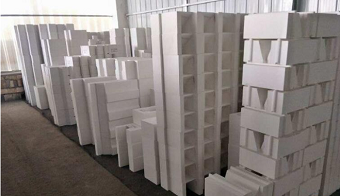Analysis of fused silica bricks from silica crystal structure, low thermal expansion and high thermal stability
2022-04-07
Fused silica brick is also called fused silica brick or thermal shock resistant silica brick. It has a very low coefficient of thermal expansion, excellent resistance to rapid cooling and rapid heating, good high temperature structural strength, high SiO2 content. This product can be widely used in the rapid thermal repair of various coke ovens. The product does not have cracks and spalling during use, and the low thermal expansion performance is close to zero, which makes the coke ovens safe and reliable for long-term use after repairing.
The following mainly analyzes the low thermal expansion and high thermal stability of zero-expansion silica bricks from the crystal structure of silica:
(1) The main mineral phase of fused silica brick is amorphous cinnamon dioxide, accounting for more than 90%
Fused silica brick is made of high-grade quartz ore through electric arc furnace melting, cooling, crushing, screening, pickling and other processes to prepare fused silica material, and its particles are mixed with a small amount of mineralizer and sintering agent to form semi-dry mud It is made by pressing, drying and firing process. The main mineral component is amorphous amorphous fused silica. The thermal expansion coefficient of the zero-expansion silica brick mainly composed of amorphous fused silica is only 0.55×10', and the thermal expansion coefficient of the product is almost zero, so it is called zero-expansion silica brick.

(2) Atomic structure of amorphous amorphous fused silica
The same is silicon dioxide, and the structure of amorphous SiO2 is different from that of crystalline SiO2. The above picture shows a silicon-oxygen tetrahedron [SiO4] composed of every silicon atom and oxygen atom of crystalline silicon oxide, and each tetrahedron passes through the corners. The connection becomes a three-dimensional network structure; the following figure shows the structure of amorphous silicon oxide. It can be seen that the disordered amorphous SiO2 has vacancies in its silicon-oxygen bond, and its atomic structure is long-range disordered. The bond angles are irregularly distorted to form three-dimensional cross-links.
The thermodynamic properties of the material are determined by the atomic crystal structure. SiO2 has a variety of isomorphic structures. The crystal phases formed under different conditions have different structures, so the thermodynamic properties are different.
Crystalline SiO2—Once the heated bond angle changes, the isomorphic transformation begins at 180°C, accompanied by a huge volume expansion, so the thermal stability is extremely poor, and it will crack after being cooled by water at 1100°C. Amorphous SiO2 has the characteristics of small thermal expansion coefficient, excellent thermal stability, high high temperature viscosity, and low thermal conductivity. However, amorphous SiO2 is an unstable state at high temperature, and no volume change occurs when heated within 1100 °C, but as the temperature increases, amorphous SiO2 begins to crystallize. It can well meet the construction requirements.
In the production process of zero-expansion silica brick, effective measures are taken to control the crystallization speed and crystallization ratio of amorphous amorphous fused silica at high temperature, so that it can better meet the thermal repair requirements.
(3) Thermal stability testing of zero-expansion silica bricks
Figure 2 shows: after heating the Qin-expanded silica brick to a high temperature of 1100 °C, it was immediately put into the water at room temperature, and there was no change after 30 water-cooling cycle tests. Figure 3 shows that after placing the zero-expansion silica brick directly from room temperature to a high temperature of 1500 °C for 12 hours, the actual test results of taking out no change also prove that the thermal stability of the zero-expansion silica brick is superior.
Relevant information
-

Silicate fire brick
Silicon thermal insulation refractory brick refers to the thermal insulation refractory products made of silica as the main raw material, with a SiO2 content of no less than 91%. In addition to the heat insulation perfor··· -

silica bricks manufacturing process
1.1 Determination of raw material ratio and particle compositionThe raw materials for making silica bricks are silica and waste bricks containing more than 96% SiO2, in addition to lime, mineralizers and organic binders.··· -

Alumina hollow ball bricks
Alumina hollow ball bricks are made of alumina hollow balls and alumina powder as the main raw materials, combined with other binders, and fired at a high temperature of 1750 degrees. It belongs to a kind of ultra-high t··· -

Anti-stripping high alumina brick for cement kiln
Anti-stripping high alumina bricks are made of high alumina bauxite clinker, mullite, kyanite, zircon sand, and binder first through granulation and powdering processes, mixed in a certain proportion, then pressed into s···

